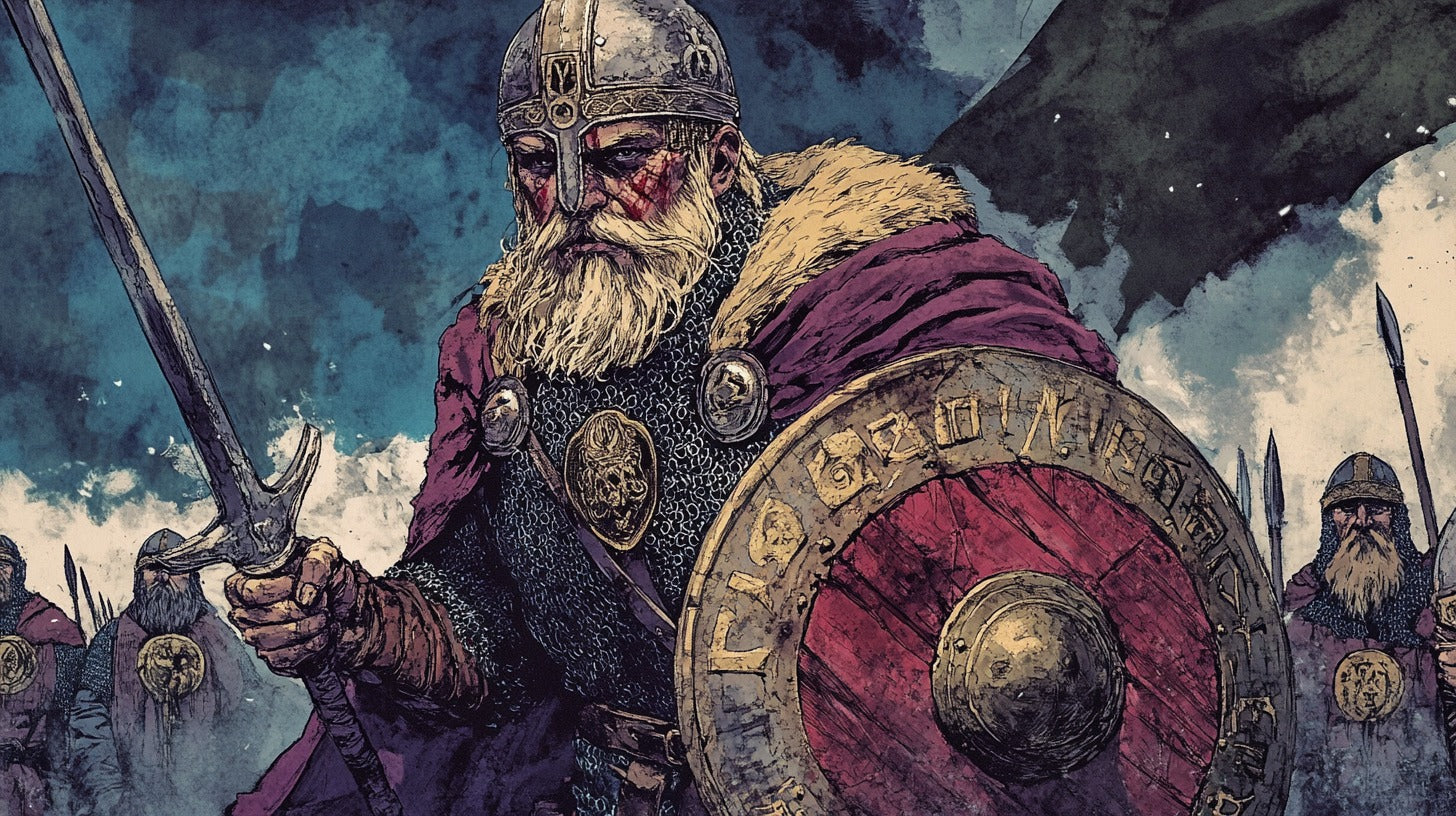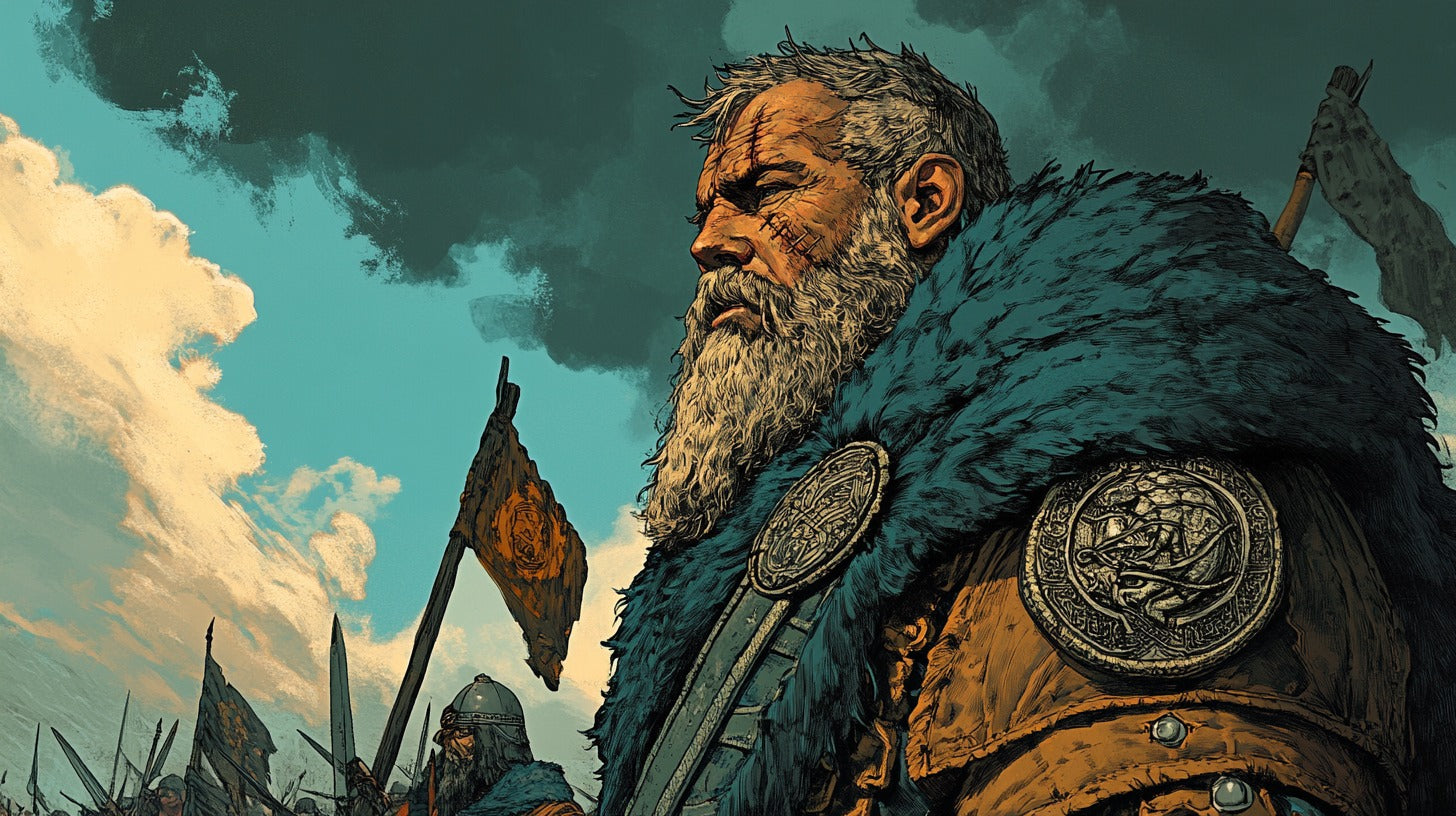
Godfrið: The Danish King Who Challenged Charlemagne
In the early 9th century, the power dynamics of Europe were shifting dramatically. The Carolingian Empire, under the reign of Charlemagne, was expanding its influence, while Denmark, under the rule of King Godfrið, was emerging as a significant force in the north. The conflict between these two formidable leaders, Godfrið and Charlemagne, became a pivotal moment in European history, shaping the future of the region for decades to come.
Historical Context: Frankish Empire, Charlemagne & Denmark

Approximate realm of Gudred (Illustration: Tinkaer1991 CC BY-SA 4.0)
By the year 800, Charlemagne had established a vast empire spanning much of Western and Central Europe. His coronation as Emperor of the Romans by Pope Leo III on Christmas Day of that year marked the pinnacle of his power and influence. The Frankish Empire's expansion brought it into contact – and often conflict – with neighboring peoples, including the Saxons, Slavs, and Danes.
Denmark in the early 9th century was a collection of chiefdoms and petty kingdoms, gradually coalescing into a more unified state. The Danish people were known for their seafaring skills and had begun to engage in raids and trade missions across the North Sea and Baltic regions. This period marks the beginning of what historians later termed the Viking Age, characterized by Scandinavian expansion, exploration, and raiding activities.
Godfrið's Rise to Power

Information about Godfrið's early life is scarce, as is often the case with figures from this period. He first appears in historical records as the King of Denmark around 804 CE. The exact circumstances of his ascension to power are not well-documented, but it is likely that he emerged as a powerful chieftain who managed to unite various Danish factions under his rule.
Upon becoming king, Godfrið worked to consolidate his power within Denmark. He strengthened his position by forging alliances with local chieftains and expanding his influence over the Danish isles and Jutland peninsula. His ability to unite the Danish people under a single leadership was crucial for the events that would follow.
Conflict with Charlemagne

Danevirke located in Shcleswig-Holstein, Germany (Formerly Denmark), now a UNESCO World Heritage Site / Photo: Willi Kramer
The conflict between Godfrið and Charlemagne was rooted in the expanding spheres of influence of both rulers. As Charlemagne's empire pushed northward, particularly with the conquest of Saxony, it came into direct contact with Danish territories. This expansion threatened Danish independence and control over important trade routes.
The Danevirke fortification
One of Godfrið's most significant actions was the strengthening of the Danevirke, a system of defensive fortifications across the neck of the Jutland peninsula. The Royal Frankish Annals, a primary source for this period, record that in 808, Godfrið "came with his fleet and all the horsemen of his kingdom to the place called Sliesthorp, on the border of his kingdom and Saxony" (Royal Frankish Annals, entry for 808). Here, he oversaw the reinforcement of the Danevirke, demonstrating his defensive strategy against potential Frankish incursions.
Godfrið also focused on expanding Danish naval power. He increased the size of the Danish fleet and began conducting raids on Frisian coasts, which were under Frankish control. These actions were likely intended both to disrupt Frankish trade and to demonstrate Danish military capabilities.
The Campaign of 810: Godfrið's Invasion of Frisia
The tensions between Godfrið and Charlemagne culminated in 810 when the Danish king launched a major invasion of Frisia. The Royal Frankish Annals report that Godfrið "attacked the Frisians with a naval force, landed an army on their shores, and defeated the Frisians in three battles" (Royal Frankish Annals, entry for 810). This bold move directly challenged Charlemagne's authority and threatened the northern borders of his empire.
Charlemagne's reaction to Godfrið's invasion was swift. He mobilized his forces and personally led an army northward to confront the Danish threat. The emperor established his camp at Verden on the Aller River, preparing for a major campaign against Godfrið.
Before the anticipated clash between the two rulers could occur, events took an unexpected turn. In late 810, Godfrið was assassinated by one of his own retainers. The Royal Frankish Annals tersely state: "But while he was in his camp, Godfrið was killed by one of his own bodyguards" (Royal Frankish Annals, entry for 810). The exact circumstances and motivations behind the assassination remain a subject of historical debate.
Legacy and Historical Significance

Godfrið's reign and his conflict with Charlemagne had a lasting impact on Danish-Frankish relations. His aggressive policies and the threat he posed to the Frankish Empire led to increased Frankish interest and involvement in Scandinavian affairs. This engagement would continue under Charlemagne's successors, shaping the political landscape of Northern Europe for decades to come.
Godfrið's expansion of Danish naval power and his raids on Frisian coasts can be seen as precursors to the more extensive Viking raids and conquests that would characterize the latter part of the 9th century and beyond. His reign demonstrated the potential for Scandinavian rulers to challenge the established powers of Western Europe, a pattern that would be repeated and expanded upon by later Viking leaders.
Godfrið, King of Denmark, stands as a significant figure in early medieval European history. His challenge to Charlemagne's authority and his efforts to strengthen Danish power marked a crucial moment in the interactions between Scandinavia and the Frankish world. Although his reign was cut short by assassination, Godfrið's actions set the stage for future Viking activities and influenced the course of Northern European history. His legacy serves as a reminder of the complex political landscape of the early medieval period and the pivotal role played by ambitious rulers in shaping that landscape.
FAQs
- Who was Godfrið and why is he important in Danish history?
Godfrið was a powerful Danish king who ruled in the early 9th century. He's important because he successfully challenged the expansion of Charlemagne's Frankish Empire and helped consolidate Danish power, setting the stage for the Viking Age.
- What was the Danevirke and why did Godfrið build it?
The Danevirke was a system of fortifications built by Godfrið to protect Denmark's southern border from Frankish invasion. It served as a physical barrier and a symbol of Danish resistance to Charlemagne's expansionist ambitions.
- Did Godfrið and Charlemagne ever actually fight in battle?
While there were tensions and military preparations on both sides, there's no historical evidence of a direct battle between Godfrið and Charlemagne. Their conflict was more about political maneuvering and shows of force.
- How did Godfrið's reign influence the Viking Age?
Godfrið's efforts to unite Danish tribes and assert Danish power on the European stage laid the groundwork for the Viking Age. His defiance of Charlemagne demonstrated that the Danes were a force to be reckoned with in European politics.
- What happened to Danish-Frankish relations after Godfrið's reign?
While open conflict was avoided during Godfrið's lifetime, tensions between the Danes and Franks continued. This set the stage for future Viking incursions into Frankish territory and shaped the political landscape of Northern Europe for generations to come.
References
Max Adams (2017) Alfred's Britain: War And Peace In The Viking Age








